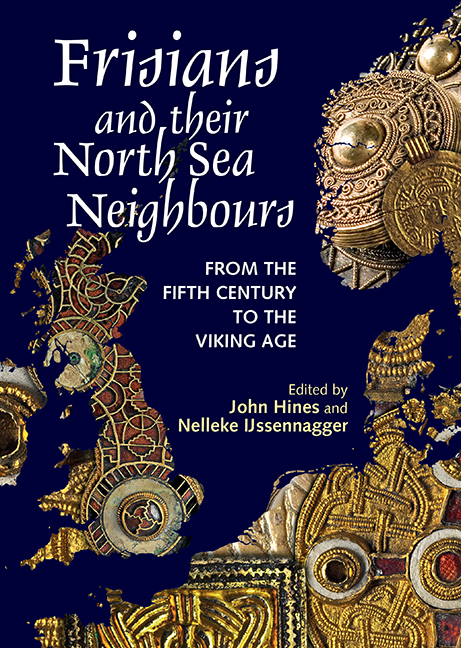Book contents
- Frontmatter
- Contents
- List of Figures
- List of Tables
- Preface
- Acknowledgements
- Linguistic Conventions and Abbreviations
- Abstracts
- Introduction: Frisians – Who, When, Where, Why?
- 1 Palaeogeography and People: Historical Frisians in an archaeological light
- 2 The Anglo-Frisian Question
- 3 Frisian between the Roman and the Early Medieval Periods: Language contact, Celts and Romans
- 4 ‘All quiet on the Western Front?’ The Western Netherlands and the ‘North Sea Culture’ in the Migration Period
- 5 Power and Identity in the Southern North Sea Area: The Migration and Merovingian Periods
- 6 How ‘English’ is the Early Frisian Runic Corpus? The evidence of sounds and forms
- 7 The Geography and Dialects of Old Saxon: River-basin communication networks and the distributional patterns of North Sea Germanic features in Old Saxon
- 8 Between Sievern and Gudendorf: Enclosed sites in the north-western Elbe–Weser triangle and their significance in respect of society, communication and migration during the Roman Iron Age and Migration Period
- 9 Cultural Convergence in a Maritime Context: Language and material culture as parallel phenomena in the early-medieval southern North Sea region
- 10 The Kingdom of East Anglia, Frisia and Continental Connections, c. ad 600–900
- 11 A Comparison of the Injury Tariffs in the Early Kentish and the Frisian Law Codes
- 12 Cultural Contacts between the Western Baltic, the North Sea Region and Scandinavia: Attributing runic finds to runic traditions and corpora of the Early Viking Age
- Index
7 - The Geography and Dialects of Old Saxon: River-basin communication networks and the distributional patterns of North Sea Germanic features in Old Saxon
Published online by Cambridge University Press: 25 August 2018
- Frontmatter
- Contents
- List of Figures
- List of Tables
- Preface
- Acknowledgements
- Linguistic Conventions and Abbreviations
- Abstracts
- Introduction: Frisians – Who, When, Where, Why?
- 1 Palaeogeography and People: Historical Frisians in an archaeological light
- 2 The Anglo-Frisian Question
- 3 Frisian between the Roman and the Early Medieval Periods: Language contact, Celts and Romans
- 4 ‘All quiet on the Western Front?’ The Western Netherlands and the ‘North Sea Culture’ in the Migration Period
- 5 Power and Identity in the Southern North Sea Area: The Migration and Merovingian Periods
- 6 How ‘English’ is the Early Frisian Runic Corpus? The evidence of sounds and forms
- 7 The Geography and Dialects of Old Saxon: River-basin communication networks and the distributional patterns of North Sea Germanic features in Old Saxon
- 8 Between Sievern and Gudendorf: Enclosed sites in the north-western Elbe–Weser triangle and their significance in respect of society, communication and migration during the Roman Iron Age and Migration Period
- 9 Cultural Convergence in a Maritime Context: Language and material culture as parallel phenomena in the early-medieval southern North Sea region
- 10 The Kingdom of East Anglia, Frisia and Continental Connections, c. ad 600–900
- 11 A Comparison of the Injury Tariffs in the Early Kentish and the Frisian Law Codes
- 12 Cultural Contacts between the Western Baltic, the North Sea Region and Scandinavia: Attributing runic finds to runic traditions and corpora of the Early Viking Age
- Index
Summary
North-West and North Sea Germanic: fluid perceptions
The Germanic languages witnessed a rapid series of changes between the 4th century and the 7th: from the fairly homogeneous North-West Germanic ‘Gallehus’ idiom of the 4th century, the language split into a number of dialects, which had developed fairly well recognizable linguistic identities by the time of their first attestations, dated approximately to the late 7th century (Nielsen 2000, 288–93). An important focal point of linguistic innovations (phonological and morphological) lies in the region around the North Sea, and their spread affected the adjacent dialects of Old English, Old Frisian and, to some extent, Old Saxon, which are, therefore, commonly referred to as the North Sea Germanic languages. In particular, the similarities between Old English and Old Frisian are so striking that they led earlier researchers to assume a common Anglo- Frisian unity on the Continent, which later, after the migration of the Angles and some of the Saxons to Britain, split into two languages (e.g. Siebs 1889). The perception of the affinity between North Sea Germanic languages changed entirely with Kuhn's (1955) ground-breaking paper, in which a new grouping of Germanic dialects was postulated and the concept of North-West Germanic linguistic unity – lasting approximately until the Migration Period – was introduced. A few years later, in line with Kuhn's hypothesis, DeCamp (1958) revised the understanding of the emergence of Old English dialects, showing that the bulk of the dialectal variants in Old English post-date the colonization of Britain and therefore do not reflect earlier continental dialect or tribal configurations (see also Nielsen 1998). Consequently, the new interpretation of the mutual relations between these dialects evolved into the modern perception of North Sea Germanic as a group of language varieties, participating to a lesser or greater extent in a series of linguistic innovations that have their geographical origin in the North Sea area (cf. Stiles 1995). These innovations can be dated to the period during and after the migration of the Germanic tribes to Britain. The familiar division into English, Frisian and Saxon is the result of a gradual geographical reorganization of linguistic features, which led to the enhancement of linguistic boundaries and eventually to the emergence of distinct linguistic identities (Århammar 1990; Versloot 2014a).
- Type
- Chapter
- Information
- Frisians and their North Sea NeighboursFrom the Fifth Century to the Viking Age, pp. 125 - 148Publisher: Boydell & BrewerPrint publication year: 2017

